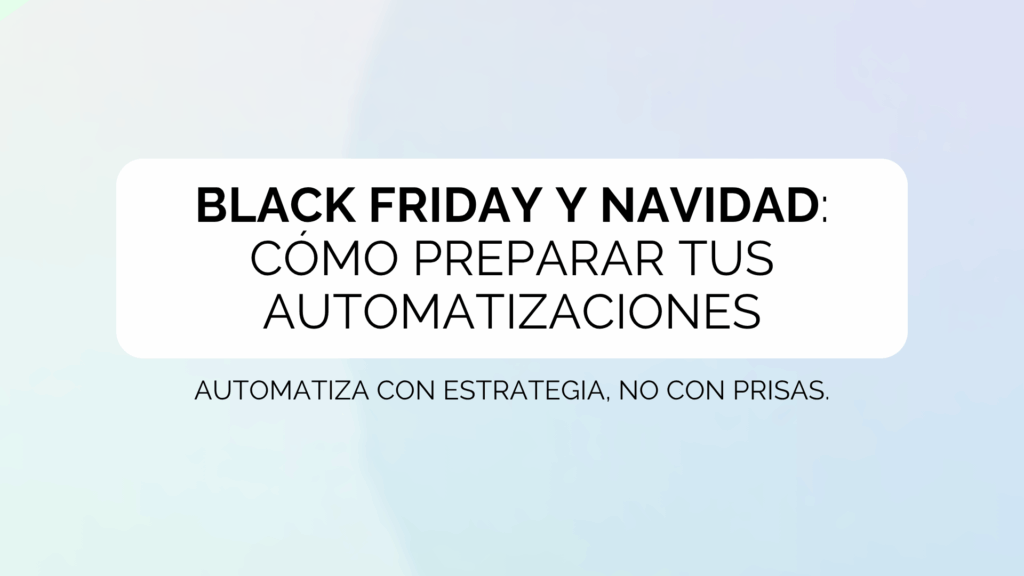Black Friday and Christmas: how to prepare your automations

Black Friday and Christmas are the two most anticipated dates in the calendar for marketing teams. A significant proportion of annual sales are concentrated in just a few weeks, and competition for the user's attention is fierce.
However, many brands are still preparing their campaigns with only a few days' lead time, limiting their ability to segment, automate and personalise messages.
The key to standing out is plan ahead and build a end-to-end automation strategy that accompanies the user from the expectation phase to post-purchase loyalty.
In this post we tell you how to plan, optimise and automate your Black Friday and Christmas campaigns in advance to maximise results.
1. Start with a strategic calendar
Planning is the cornerstone of a good campaign. Between August and September, the most advanced brands are already defining:
- Objectives and KPIsWhat do you want to achieve (sales, traffic, leads, reactivation...)?
- Hearingssegment based on previous year's behaviour (active buyers, abandoned carts, inactive subscribers, etc.).
- Shipping scheduleThe teaser phase, the launch and the after-sales phase are defined.
Council: Review the performance of your campaigns from the previous year and identify the segments that converted the most. You can then adjust your strategy and improve your automated flows.
2. Review your key automations
Before you think about messages, make sure that your automation ecosystem is ready. The most important flows for this time include:
- Sales-optimised welcome: converts new registrations with a clear incentive or a countdown to Black Friday.
- Abandoned trolleys: adapts triggers to seasonal behaviour (e.g. more frequency during offers).
- Product recommendations: updates the dynamic rules according to the current catalogue or inventory.
- Reactivation of dormant subscribers: clean up your database and launch warming campaigns before peak mailings.
Example: On platforms such as Klaviyo or Salesforce Marketing CloudYou can create seasonal versions of your automations by duplicating the flows and adapting their logic and content.
3. Prepare the pre-campaign phase
The success of Black Friday does not start on Friday. The teaser phase is crucial to attract attention and increase the number of active contacts prior to offers.
Recommended actions:
- Recruitment campaigns: use pop-ups or forms with incentives such as "Early access to Black Friday".
- Emails of expectation: create a series that arouses curiosity ("What's coming this Black Friday will surprise you").
- A/B testing: test issues, CTAs and creative before the big day.
- Priority automations: allows your subscribers to sign up to receive offers before anyone else.
Council: synchronise this phase with your paid campaigns (Meta, Google, etc.) to maintain message consistency.
4. Define your flows during Black Friday and the Christmas campaign.
During the main period (end of November to December), the key is in the automated orchestration and the real-time adaptation.
Essential flows:
- Launch: initial email with clear CTA and featured offers.
- Dynamic reminders: automations based on users who have not opened or clicked.
- Trolleys and abandoned views: maximum relevance in the personalisation of products.
- Urgency: dynamic countdown or banners with limited stock.
- Upselling and cross-selling: after purchase, automatic recommendations with complementary products.
Example: Pou can automate the frequency according to user interaction (if they open and buy, they receive fewer emails; if they don't interact, the frequency increases).
5. Don't forget post-Black Friday
Once the sales peak has passed, an equally important phase begins: loyalty and retention.
Key actions:
- Thank you and appreciation email: strengthens the link and collects feedback.
- Recommendation automations: complementary products or Christmas gift ideas.
- Loyalty campaigns: offers exclusive benefits for new buyers (points club, VIP discounts, etc.).
- Data analysis: review the flows that worked best in order to replicate them next year.
Council: many users discover the brand during Black Friday. Keep their attention with a well-designed post-purchase sequence.
6. Analyse and optimise
Once the campaign is closed, take time to review:
- Performance by segment and device.
- Open and click-through rates in automated vs. mass mailings.
- Impact on recurrence and average order value.
- Results of the A/B tests carried out.
Early analysis will allow you to optimise your automations and go into the next season with a solid foundation.
In short, tonticipating the strategy, preparing the automations and analysing in detail the performance of your flows are essential steps in order to maximising ROI and improving customer experience.
As we have said in the past, in 2026, the brands that will succeed will be those that combine data, technology and personalisation to deliver campaigns that are as relevant as they are timely.